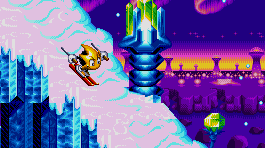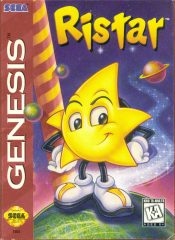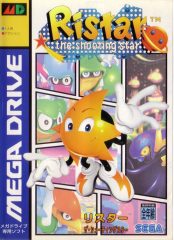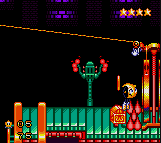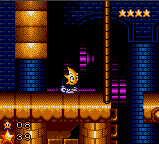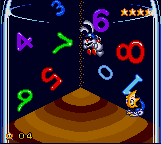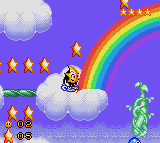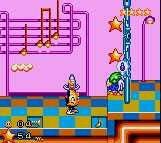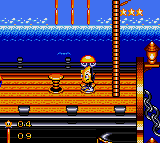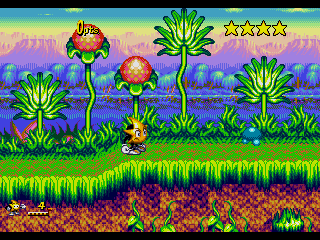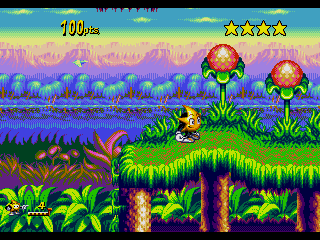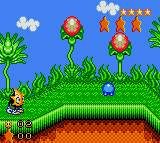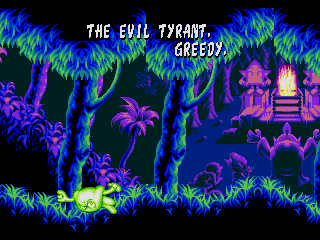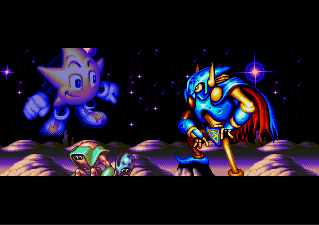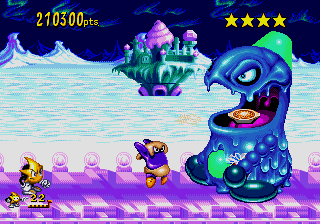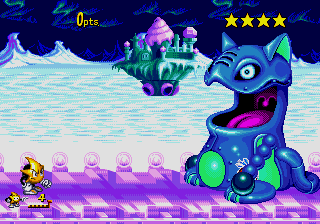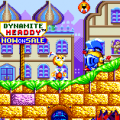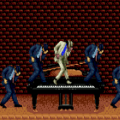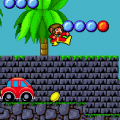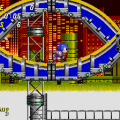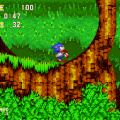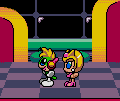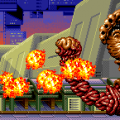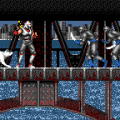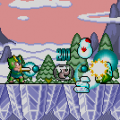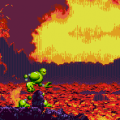by Aaron “muteKi” Kearns
Long long ago a company called Sega had a bit of an image problem. They needed their new console, the Mega Drive (Genesis to us Americans) to catch fire, especially in the US where nothing was able to enter the gaming market against Nintendo’s NES. To that end, they started a competition throughout the company — design a character to become the mascot associated with this new console, and a game to go along with it made to sell into the millions. The end result of this competition is well-known — the joint effort of Hirokazu Yasuhara (lead game designer), Naoto Ohshima (character designer and artist), and Yuji Naka (programmer) and about a dozen other people produced the classic game, Sonic the Hedgehog.
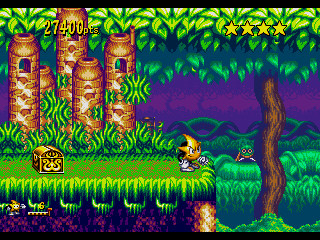
Ristar (Genesis)
However, Sonic, as the end result of their efforts, wasn’t the first idea that the group had. Before the speedy blue hedgehog and his single action button control scheme, they came up with the idea of a rabbit who would throw items to defeat enemies and pass stages. Though this idea was shelved, it came back near the end of the console’s life in the form of the game Ristar.
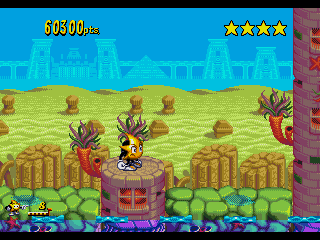
Ristar (Genesis)
Ristar‘s in-game origins differ between regions, but his mission in the game naturally remains the same — an evil king, Greedy, has taken over the planets in the Valdi system with his henchmen and his army of orbs, and Ristar is being counted on in order to rescue the enslaved people by defeating the enemies on every planet and to eventually take out Greedy himself. Ristar will do this by grabbing enemies with his extendable arms and headbutting them.
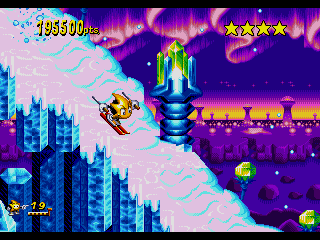
Ristar (Genesis)
On first impressions Ristar does feel a lot like Sonic, at least from the perspective of game structure. Each level has two normal stages, the first one ending with some sort of unusual mini-boss encounter, and the second stage leading into a boss battle. The game code itself is based on some of the previous Sonic games; some sound effects are recognizable to those who have played them, and the game engine is also based on that of Sonic 1. Within each normal stage is a hidden entrance to a bonus stage where the player tries to grab a special item and possibly get a continue. Ristar’s silhouette is reminiscent of Sonic, with 3 visible spikes rotruding from his head. Ristar himself is, after all, based on an early concept for Sonic that was canned for the sake of gameplay that wouldn’t require the player to use more than one action button in order to do anything to simplify and speed up gameplay.
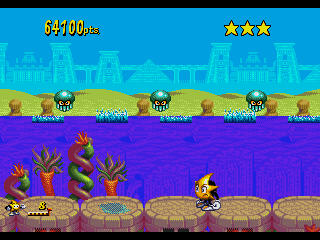
Ristar (Genesis)
However, given more time to get accustomed to the game, Ristar plays and feels more like a combination of Dynamite Headdy and Rocket Knight Adventures. Ristar has an 8-way attack using his extendable limbs, and stretches them out to grab things as a form of platforming, just as Headdy’s head does. By grabbing onto poles found in pretty much every level, Ristar can pick up speed; upon releasing he launches off at high speed where he bounces off walls and becomes invincible, like Sparkster in Rocket Knight Adventures. Ristar‘s health system is more similar to those two games as well — taking damage removes away one of 4 health stars (once they’re all gone, Ristar dies, naturally), which can be restored by grabbing additional ones hidden throughout the level. There’s also a hidden super-hard mode where one hit will kill Ristar, like those found in the other two games.
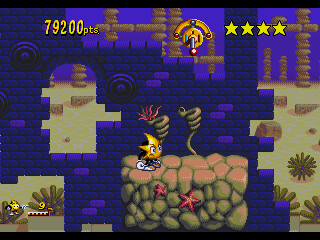
Ristar (Genesis)
The similarities continue. One of Ristar‘s level inpirations is taken straight out of the SNES Sparkster: it is a music-based level with obstacles like timpani drums that act like trampolines and piano-based platforms that plunk out notes as you stand on them. The bonus stages, unlike in Sonic the Hedgehog, don’t use a different engine and are more like Dynamite Headdy‘s tutorial levels: played in order to unlock codes at the end of the game and also for continues (if cleared quickly enough), they involve using skill with various common level design elements like the previously mentioned poles, trampoline-drum platforms, and other obstacles like monkey bars and grabbable ledges.
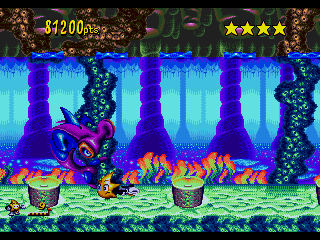
Ristar (Genesis)
Speaking of that, nearly every ledge in Ristar is grabbable in some form; ceilings and walls can be repeatedly attacked to stay up in the air, though it’s not really possible to use this to reach higher platforms without something to get a steadier hand-hold onto like monkey bars or a pipe, the latter of which Ristar will grab onto and swing across. Sometimes simply climbing up walls without handholds by attacking them is key to getting secret treasure like extra health or lives. (Similar bonuses are found lying around in the middle of levels in treasure chests — these can be gotten simply by attacking the chests.) Using these sorts of methods to climb is the main way that Ristar gets around, and is essential to conquering some of the later bonus stages successfully. One of the few exceptions to the grabbable ledges are the iced-over ones in the snow levels. Rather than shimmy up the ledge, Ristar instead draws back and shivers a little bit.
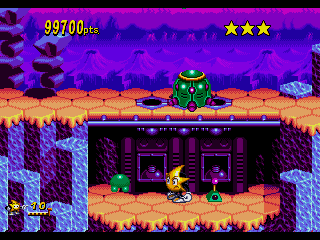
Ristar (Genesis)
Despite the fact that Ristar doesn’t have a lot of different types of levels (everything’s a platforming level; there are no special racing or shooting segments like its inspirations) each one retains a very unique feel; many stages have unique gimmicks aside from simply reaching the end of the level that keeps the game fresh. The second level is a water planet, where Ristar must swim around in order to get anywhere; unlike water levels in most games, Ristar is actually more maneuverable and is still able to attack enemies freely. In fact, Ristar is able to move faster in water than on land. The second stage on that planet (each planet has two main stages and a boss) has Ristar swimming from room to room, destroying an enemy or groups of enemies in order to progress into the next one. The third level is a fire planet, where Ristar has to avoid lava surges like in the first part of the third level of Rocket Knight Adventures, though the lava isn’t a one-hit-kill obstacle; there are also meteors that fall in certain places that Ristar can attack for bonus health and lives. The fourth level is the previously mentioned music level; the first stage is spent finding and transporting metronomes to give to birds throughout the level to get them to let you pass. In the end, though Ristar never learns any real new moves or techniques over the course of the game (barring perhaps sliding on slippery surfaces and swimming within water), the game succeeds in preventing the gameplay from becoming stale.
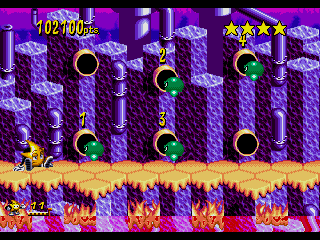
Ristar (Genesis)
Many mini-boss and boss fights are unusual, too. One boss fight plays out much like a game of Simon, where Ristar must attack the enemies in a specific order; failing causes damage while success leads to bonuses. Another one is a snowball fight against a chimpanzee-like character; Ristar actually has to stand still (and make himself a target) in order to form snowballs to pick up and throw. One of the more difficult boss battles requires Ristar to throw curries into the mouth of a giant cat-robot. Of course, most bosses are defeated by repeated normal attacks — the game makes it quite clear when this isn’t the case, though, and usually boss fights are going to be more straightforward than the minibosses. The most notable exception is the cat found at the end of the snow level.
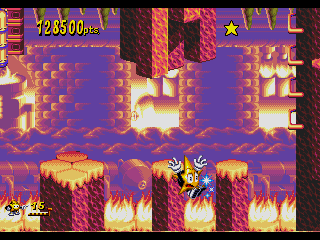
Ristar (Genesis)
Ristar is notable for having a very high-quality presentation as well. The graphics are colorful featuring pastel shading similar to a number of high-profile GBA titles; the colors are fairly dramatic and high-contrast, particularly because some levels have significant pallete changes as well — near the end of the second stage of the game, a forest level, the lights go out, leaving the level very dark (they can be turned on again by attacking certain phosphorescent trees). Similarly, the first water level gets darker and bluer the farther underwater that Ristar goes (sadly, this isn’t an effect that occurs in other water levels). Screenshots fail to do the game’s graphics justice, as there is a lot of minute detail in the background, such as multiple layers of scrolling in addition to typical parallax effects (done by a method of on-the-fly graphic updates like in Metal Storm or Sonic 3) and sprites that interact with foreground and background layers — in the background of the second stage, also near the end, the boss of the level starts throwing strawberries at you, and in the aforementioned fire planet.
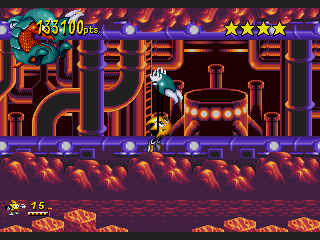
Ristar (Genesis)
The music is also excellent, though the sample playback in the game sounds a bit on the scratchy side; this seems to be due to the fact that the audio driver is actually designed to play back two PCM samples at the same time, which are mixed with software buffering; games like Dynamite Headdy were able to have much higher-quality audio samples due to the fact that the sound subprocessor didn’t have to spend extra time with these samples. Still, it allows the game to do interesting things like add vocalizations in the music level, and isn’t painful to listen to. In any case, the compositions are all excellent, particularly for the water and snow levels. They may not be arranged like the aural masterpieces that most of, for example, the music from the Treasure offerings for the Genesis or the work of Yuzo Koshiro but are especially catchy and fun to listen to.
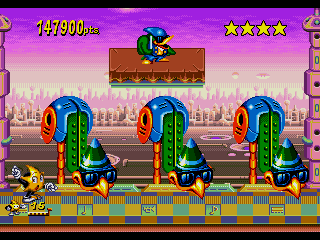
Ristar (Genesis)
Though Ristar is frequently credited as being made by “Sonic Team”, there are no references to it in the game’s credit sequence. In fact, for most of the primary members of the game’s staff, this was their first major job developing for Sega. Most of the same staff, like primary art directors, some programmers, and composer Tomoko Sasaki, would go on to develop NiGHTS…Into Dreams, which was published under the Sonic Team name (and thus crediting the game as such is not entirely inaccurate). Either way, it’s certainly a different team from any that worked on the Genesis Sonic titles, to which only Sonic 1 was actually developed under that title officially anyway; Sonic 2 and 3 were better described as being made by the US-based Sega Technical Institute, responsible for games like Kid Chameleon and Comix Zone.
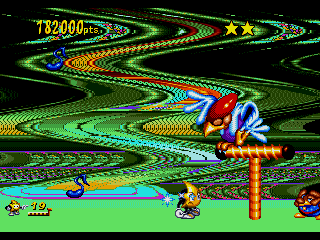
Ristar (Genesis)
Ristar, despite being very pretty and fun to play, never really got the attention it deserved. Although there are a number of factors, one of the most notable is that it was released in February 1995. Not only was the Genesis being supported much the way the PS2 has been since the launch of the PS3 — most of the releases at this point were of THQ’s updates for EA’s sports titles. In addition, the promise of 3D hardware meant people were looking to see more games developed that fully took advantage of that new dimension, pushing Ristar aside a bit more. Ristar also received a Game Gear port. Though the first level, the music level, and the final level all exist in the game and are overall quite faithful to the original, they are the only ones that survived the translation to the handheld. The other levels are replaced with two new offerings. The first is a level based around clouds and rainbows and then a pirate ship. The second has some water and ice, and is based around lots of timed gates; upon entering one, Ristar has a bomb planted on him and must quickly reach a pool of water in order to disarm it — there are timers that show how long until the bomb explodes, upon which Ristar will take damage. The first stage has both large bodies of water and ice (much like two of the levels lacking in the port), while the second takes place mainly in a large clock tower and is vaguely reminiscent of the castles in Super Mario World. The focus of each stage is reflected in the name of the level in each version: on US GG units, it is called “Freon” like the snow level from the Genesis version, though on Japanese units it is called “Timu” (perhaps meant to be reminiscent of the word “time”).
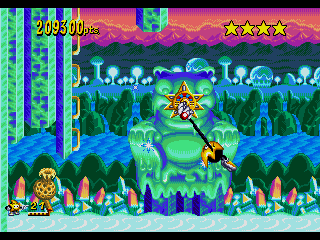
Ristar (Genesis)
The Game Gear port isn’t as flashy as the Genesis version due to the scaling-down of the hardware, and is a level short. The boss of the fire level, otherwise completely missing, is added to the final boss gauntlet; the two new stages have unique bosses though the fantasy level boss is fought by throwing projectiles at it much like the boss of the ice level in the Genesis version. Another notable change is that the bonus stages are entered at the end of each level only after collecting a hidden planet-shaped item in each of the two stages; it is played for points and star-collecting, a feature unique to this version. Collecting 100 of the giant stars found throughout the levels gets an extra life (basically making them equivalent to coins in the 2D Mario games). Since the game is shorter and also lacks all but one of the minibosses from the Genesis game, some of the levels taken from the Genesis game have been rearranged and often made slightly harder. Some of the basic enemy orbs are more aggressive — some now occasionally flash with lightning, where they can’t be grabbed, for example — and most levels have slightly modified obstacles to get past. The game is filled with enemies unique to this version, many particularly unusual in their appearance like fat orange men and a giant blue blob which throws out small projectiles. There’s also a bit more of the item-throwing mechanic; some enemies drop their weapons when killed which can be thrown at other enemies to kill them or at obstacles to facilitate Ristar’s travel through the stage.
Ultimately, the Game Gear version may not be quite as fun or visually interesting as the original version but is still colorful and quite playable. Furthermore, enough new segments and features have been added that it feels significantly distinct from the original Genesis release. It’s definitely worth looking into, though the full experience (due to the cutting of a whole level) is only really possible when playing it on a Japanese system (see below).
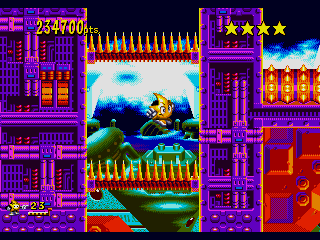
Ristar (Genesis)
The Japanese and foreign (American and European) versions of each of the two have a number of small localization quirks (yet another similarity shared with Rocket Knight Adventures and Dynamite Headdy). The most notable is that the intro in the foreign (non-Japanese) versions features text and references the inhabitants of the planetary system the game takes place in praying to a god, who sends Ristar (his son) in his place. The Japanese version lacks text entirely and instead features the figure of the goddess Oruto, who summons Ristar instead. In all versions of the Game Gear release (likely due to graphical and space constraints), the intro follows the same format of the Japanese Genesis version. The planet names are changed in the non-foreign releases and are a bit more descriptive of the planet for English speakers (the water planet Leatow becomes Undertow and the fire planet Onaclove becomes Scorch, for example). The cat robot is also changed in the foreign versions so that it is some kind of ogre snowman blob thing. In Japan, a “cat tongue” is someone who dislikes hot or spicy foods, and so for the boss, it implies that you need to use something hot to beat him. This reference is naturally lost to everyone outside of Japan.
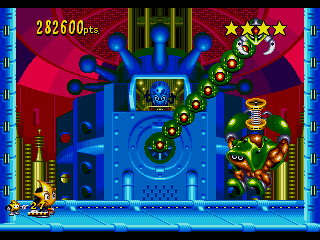
Ristar (Genesis)
The endings are also altered to reflect the changes in story — the Japanese version shows the final bosses of the game on a desolate planet staring into space while a shadowy figure of Ristar looks back at them, while the foreign versions have Ristar jumping into the arms of his father. Also, the European version took advantage of the slower PAL pixel clock and plays at a higher resolution than the other versions of the game — it was one of the few Genesis titles to take advantage of this. That said, this resolution improvement is very minor and on most older televisions probably will not be noticeable due to overscan.
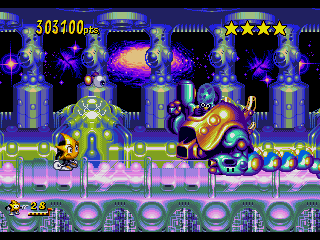
Ristar (Genesis)
Another interesting difference is that in the Japanese versions, Ristar had two different expressions while standing/idling — a happier one during the normal levels and a more serious one during the boss stages. In the foreign release, he is scowling all the time, much like Kirby on most of his American box art. (Oddly enough, although the two versions have different box art, Ristar is smiling in both of them.) Many enemies have had graphical alterations as well, to appear more menacing.
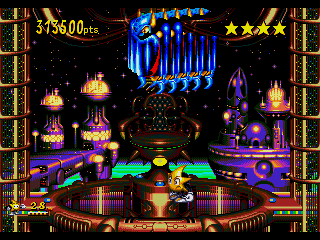
Ristar (Genesis)
The Japanese version had a lot of extra hidden codes, though most of them did fairly little; most simply displayed a strange message. One actually shows the Valdi system itself, and can be rotated around and zoomed in or out (due to the console’s limitations, the planets themselves do not change size but the difference between them does). Further, the Valdi system is only actually referenced in-game in the Japanese version (a small graphic appears between stages).
One last major difference is that the foreign release had an extended skiing segment at the start of the snow level — this was completely absent in the Japanese version. It seems to have been inspired by that of Sonic 3 but, unlike in that game, is not interactive. Since there isn’t even another instance of skiing in the level it seems tacked on and a bit unnecessary.
Aside from continuing the renaming of planets amid localization as previously noted, the Game Gear version lacks a whole stage — the first stage of the second level, Fanturn (the one based around clouds and pirate ships) — when playing the game on a non-Japanese system. Instead, only the second stage is accessible and the world renamed “Terra” (even the sound test entry for the stage is missing). Although, as noted, the intro remains the same for all regions, this change is significantly more egrigious. It also may marginalize the idea of the level being a “dream” world which is evident from the boss of the stage is a sleeping tapir that throws pillows at you, and when he is sleeping the background changes. It is possible this was changed because the level’s focus was not immediately obvious to the localization staff and removed it to be less confusing, but it’s unclear how they felt the sleeping tapir was immediately evocative of a large pirate ship and not a land of clouds and rainbows. It might also be that it was considered too dull or empty as it has fewer obstacles or enemies compared to the level length, relative to the other stages in the game.
While the Genesis localizations used a different ROM (that is, the cartridges in Europe and the US use the same binary while the Japanese release was unique) which reflects the changes in localization, the Game Gear version was a single ROM for all regions. Thus all the data for the removed stage still exists in all copies of that release (making its removal even more questionable), and its removal cannot be overridden simply by purchasing a foreign copy of the game — the hardware itself must either be modified or a Japanese system be purchased. Also interestingly, though the Japanese version of the Genesis game cannot be played on other consoles without a crack (by Game Genie or Action Replay), the foreign release is completely region free.
Beta information on Ristar is hard to find. Although there are a number of magazine scans that feature prerelease screenshots, there are no beta ROMs to be found in that regard. A few betas of the foreign release have been leaked, but these are already close to the completed version (and likely weren’t given to the localization staff until the game was close to finished anyway). However, the scans that have been found show a significant change in design to Ristar himself. He looks more like his rabbit roots rather than a star, and the game name also is called Feel (perhaps in reflection of Ristar’s groping attacks). No screenshots of the opening sequence from this stage of development seem to exist, though, so it’s unclear if Ristar‘s star-nature was emphasized. That said, as Japanese culture associates rabbits with the moon (much as in western culture there are legends of the man in the moon or it being made of green cheese), it’s probable that this prototype Ristar still had his story origins in the heavens. In any case, while it may not be a flashy demoscene release like The Adventures of Batman and Robin and may not have solidified the genre as still viable on 16-bit platforms through commercial success the way Donkey Kong Country did, Rista remains a very solid platformer on the Genesis and a very solid 2D platformer that is, if criminally ignored by the mainstream, a well-regarded classic among those familiar with it.
While Ristar may not have achieved much fame when initially released, Sega has been featuring his game on many of their compilations, including the Sonic Mega Collection (for GameCube, Xbox and PlayStation 2), Sega Genesis Collection (for Playstation 2 and PSP), and Sonic’s Ultimate Genesis Collection (for Xbox 360, Playstation 3, and Windows). It’s also available on the Wii Virtual Console. The emulation on these is decent, with the Sonic’s Ultimate Genesis Collection being the best of the bunch.
Links:
Sega – Ristar Official Sega page for Ristar.
Sega Retro – Ristar Sega Retro page for Ristar.
Ristar Fansite Includes more in-depth comparison between regions and early magazine scans.
